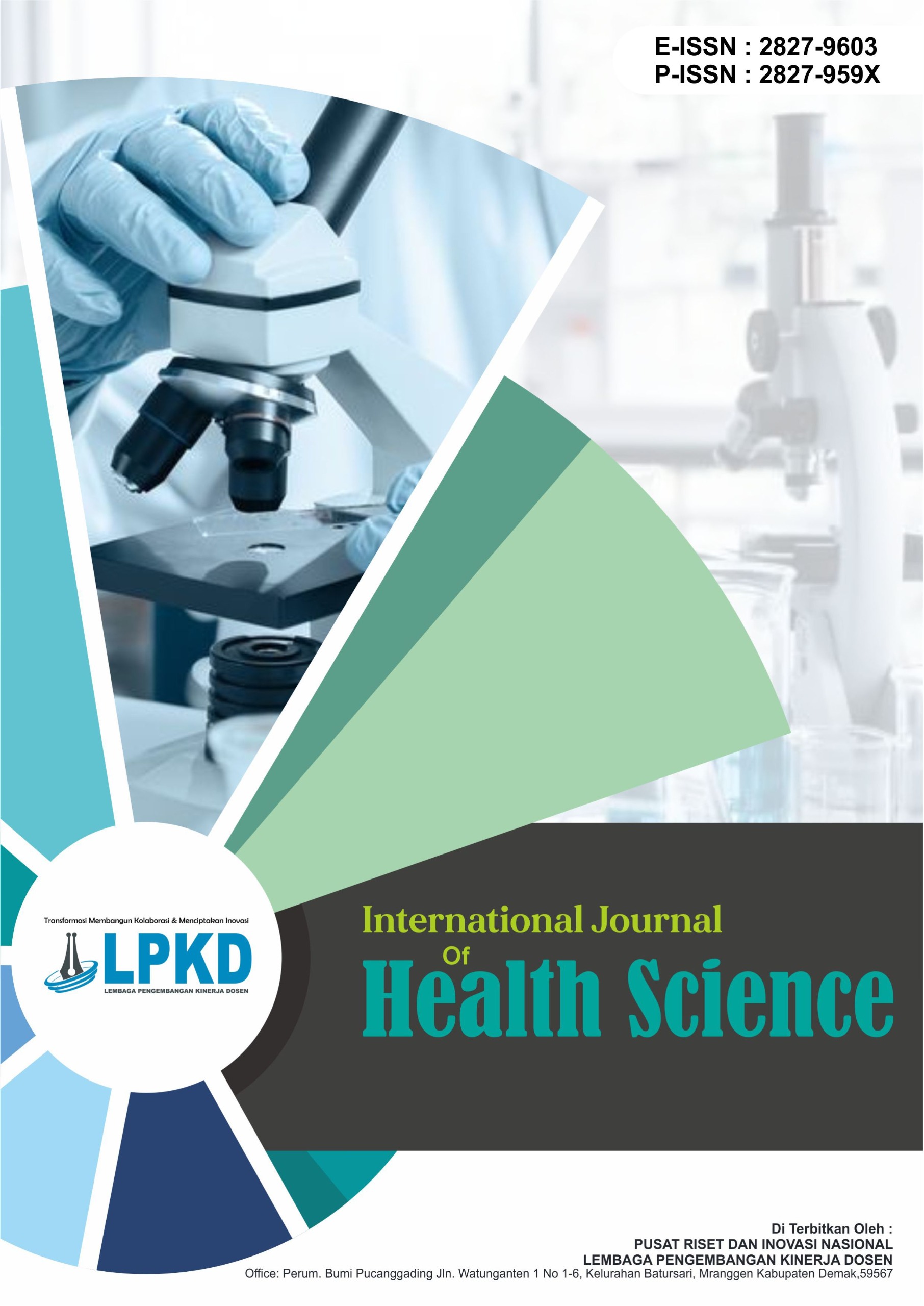Modified TR Band Application Technique for the Prevention of Hemostasis-Related Complications in Transradial Percutaneous Coronary Intervention (PCI)
DOI:
https://doi.org/10.55606/ijhs.v5i1.5122Keywords:
TR Band, Hemostatis, Technique Modification, Trans Radial AccessAbstract
The Trans Radial Band (TR Band) is a compression method applied to the radial artery following percutaneous coronary intervention (PCI). Prolonged TR Band removal duration may increase the risk of complications, while premature removal can lead to bleeding. This systematic review aims to evaluate the effectiveness of various modified TR Band application techniques in enhancing hemostasis and preventing vascular complications after transradial PCI. The study followed PRISMA guidelines, with literature searches conducted in PubMed, Scopus, and Google Scholar using specific keywords related to TR Band and its modifications. The results show that several modification techniques—including the use of rollers, slow deflation protocols, dual TR Band application, and hemostatic patches made from chitosan and potassium ferrate—generally improve hemostatic effectiveness, reduce hematoma incidence, and enhance patient comfort. However, limitations such as small sample sizes and the lack of long-term data remain challenges. Conclusion: Modified TR Band techniques are considered safe and effective, but larger-scale studies are still needed.
Downloads
References
[1.] Batra A, Gupta V, Arora S. Transradial versus transfemoral access for percutaneous coronary interventions: A systematic review and meta-analysis. J Am Coll Cardiol. 2020;75(9):1063–74. https://doi.org/10.1016/j.jacc.2019.12.062
[2.] Bertrand OF, De Larochellière R, Rodes-Cabau J, et al. A randomized study comparing same-day home discharge and overnight hospitalization after uncomplicated transradial coronary stenting. Am Heart J. 2010;160(4):732–9. https://doi.org/10.1016/j.ahj.2010.06.037
[3.] Dutta S, Biswas A, Sharma S, et al. Feasibility and Immediate Safety of Distal Transradial Access in Coronary Intervention. Indian Heart J. 2020;72(3):240–5. https://doi.org/10.1016/j.ihj.2020.02.003
[4.] Habib A, Shah S, Raza A, et al. Outcomes of a Modified Technique for Deflation of Distal Radial Artery Occlusion Device After PCI. Cardiol Cardiovasc Med. 2023;7(2):88–94. https://doi.org/10.55729/2000-9666.1227
[5.] Imbrìaco G, Russo V, De Luca G, Piccolo R. Transradial approach for coronary interventions: A review of the literature. Cardiovasc Interv Ther. 2022;37(3):200–11. https://doi.org/10.15420/icr.2016:21:3
[6.] Jia T, Wang X, Liu L. Observation on the Effect of Roller-Assisted Balloon Compression Hemostat After PCI. J Clin Med Res. 2022;14(5):201–7. https://doi.org/10.1177/09287329241296774
[7.] Khan M, Patel A, Raza M, Shaukat A. Complications of transradial access: A comprehensive review. Catheter Cardiovasc Interv. 2025;95(2):E234–40. https://doi.org/10.1002/ccd.30678
[8.] Kiemeneij F, Laarman GJ. Percutaneous transradial artery approach for coronary stent implantation. Catheter Cardiovasc Diagn. 1997;40(3):243–7. https://doi.org/10.1002/ccd.1810300220
[9.] Kiemeneij F. Left distal transradial access in the anatomical snuffbox for coronary angiography (ldTRA) and interventions (ldTRI). EuroIntervention. 2017;13(7):851–7. https://doi.org/10.4244/eij-d-17-00079
[10.] Kementerian Kesehatan Republik Indonesia. Riset Kesehatan Dasar (Riskesdas) 2018 https://sehatnegeriku.kemkes.go.id/baca/umum/20210927/5638626/penyakit-jantung-koroner-didominasi-masyarakat-kota/
[11.] Kementerian Kesehatan Republik Indonesia. Riset Kesehatan Dasar (Riskesdas) 2018 https://repository.badankebijakan.kemkes.go.id/id/eprint/3514/1/Laporan%20Riskesdas%202018%20Nasional.pdf
[12.] Medranda GA, Omer S, Hoang A, Khouzam RN. The effect of potassium ferrate patch in combination with TR Band on hemostasis after transradial coronary intervention. J Interv Cardiol. https://eurointervention.pcronline.com/article/radial-haemostasis-is-facilitated-with-a-potassium-ferrate-haemostatic-patch-the-statseal-with-tr-band-assessment-trial-stat
[13.] Moussa ID, Mohananey D, Saucedo J, et al. Transradial access for PCI in women: Current evidence and future directions. Catheter Cardiovasc Interv. 2020;96(3):524–30. https://doi.org/10.1002/ccd.28776
[14.] Nakamura S, Inoue K. Distal transradial approach for coronary intervention: An updated review. Interv Cardiol Rev. 2021;16:e09. https://doi.org/10.15420/icr.2021.09
[15.] Neumann FJ, Sousa-Uva M, Ahlsson A, et al. 2018 ESC/EACTS Guidelines on myocardial revascularization. Eur Heart J. 2019;40(2):87–165. https://doi.org/10.1093/eurheartj/ehy394
[16.] Patel TM, Shah SC, Pancholy SB. Distal radial artery access for coronary and peripheral procedures. JACC Cardiovasc Interv. 2021;14(7):892–906. https://doi.org/10.1016/j.jcin.2021.02.028
[17.] Rajeev A, Nandini A, Surya P. Safe and Rapid Radial Hemostasis Achieved Using a Novel Topical Hemostatic Patch. Vasc Health Risk Manag. 2021;17:563–70. https://doi.org/10.1002/ccd.29529
[18.] Shunsuke A, Kiyoshi T, Hiroshi I. Transulnar Catheterization in Patients with Failed Ipsilateral Transradial Access. Jpn Heart J. 2020;61(2):151–8. https://doi.org/10.1016/j.carrev.2020.06.018
[19.] Sgueglia GA, Di Giorgio A, Gaspardone A, Babunashvili A. Anatomic snuffbox approach: A new access site for coronary and peripheral procedures. JACC Cardiovasc Interv. 2020;13(14):1571–9. https://doi.org/10.1016/j.jcin.2020.04.024
[20.] Tomasello SD, Giarrusso M, Lupo C, et al. Safety and efficacy of transradial access for complex coronary interventions. J Cardiovasc Med. 2017;18(4):258–63. https://doi.org/10.2459/JCM.0000000000000486
[21.] Watanabe Y, Miyamoto T. Latest insights into complications of transradial approach. Curr Cardiol Rep. 2022;24(6):769–79. https://doi.org/10.1080/14779072.2019.1675510
[22.] World Health Organization (WHO). Global Health Estimates: Leading Causes of Death. 2023. Available from: https://www.who.int/data/gho/data/themes/mortality-and-global-health-estimates
Downloads
Published
How to Cite
Issue
Section
License
Copyright (c) 2025 International Journal Of Health Science

This work is licensed under a Creative Commons Attribution-ShareAlike 4.0 International License.







